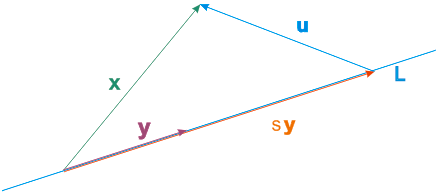We know that the projection vector has the direction of \(\Vect{y}\). So
there is a number \(t\) with \(\OrthoPrjctnOf{L}{\Vect{x}} = \SclrPr{t}{\Vect{y}}\). For a given number \(t\), set
\(\Vect{u} \DefEq \Vect{x} - \SclrPr{t}{\Vect{y}}\) so that \(\Vect{x} = \SclrPr{t}{\Vect{y}} + \Vect{u}\).

Then \(\Vect{u}\) is perpendicular to \(L\) if and only if \(\DotPr{\Vect{u}}{\Vect{y}} = 0\).

We find the number \(t\) for which this happens by dot producting both sides of the equation \(\Vect{x} = t\cdot \Vect{y} + \Vect{u}\) with \(\Vect{y}\):
|
\(\DotPr{ \Vect{x} }{ \Vect{y} }\)
|
\(=\)
|
\(\DotPr{ (t \Vect{y} + \Vect{u}) }{ \Vect{y} }\)
|
|
\(=\)
| \( \DotPr{ (t \Vect{y}) }{ \Vect{y} } + \DotPr{ \Vect{u} }{ \Vect{y} }\)
|
|
\(=\)
|
\(t ( \DotPr{ \Vect{y} }{ \Vect{y} }) + 0\)
|
|
\(t\)
|
\(=\)
|
\(\dfrac{ \DotPr{ \Vect{x} }{ \Vect{y} } }{ \DotPr{ \Vect{y} }{ \Vect{y} } }\)
|
It remains to show that \(\OrthoPrjctnOf{L}{\Vect{x}}\) is perpendicular to \(\Vect{x} - \OrthoPrjctn{L}{\Vect{x}}\); i.e. we need to check that the dot product of the two vectors vanishes. So we compute
|
\(\DotPr{ \Vect{y} }{ (\Vect{x} - \OrthoPrjctnOf{L}{\Vect{x}}) }\)
| \(=\) | \(\DotPr{ \Vect{y} }{ \left( \Vect{x} - \dfrac{ \DotPr{ \Vect{x} }{ \Vect{y} } }{ \DotPr{ \Vect{y} }{ \Vect{y} } }\cdot \Vect{y} \right) }\) |
|
\(=\) | \(\DotPr{ \Vect{y} }{ \Vect{x} } - \dfrac{ \DotPr{ \Vect{x} }{ \Vect{y} } }{ \DotPr{ \Vect{y} }{ \Vect{y} } }\cdot \DotPr{ \Vect{y} }{ \Vect{y} }\) |
|
\(=\) | \(\DotPr{ \Vect{y} }{ \Vect{x} } - \DotPr{ \Vect{x} }{ \Vect{y} }\) |
|
\(=\) | \(\DotPr{ \Vect{x} }{ \Vect{y} } - \DotPr{ \Vect{x} }{ \Vect{y} }\) |
| \(=\) | \(0\) |
So the two vectors in question are, indeed, perpendicular. – This completes the proof.

